
Amanita citrina, commonly known as the false death cap or citron amanita, is a basidiomycotic mushroom, one of many in the genus Amanita. It grows in silicate soil in the summer and autumn months. It bears a pale yellow or sometimes white cap, with white stem, ring and volva. Though not deadly, it is inedible and often confused for the lethal death cap.
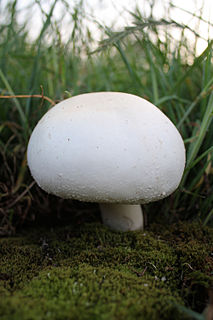
Agaricus arvensis, commonly known as the horse mushroom, is a mushroom of the genus Agaricus.

Hypsizygus tesselatus is an edible mushroom native to East Asia. It is cultivated locally in temperate climates in Europe, North America and Australia and sold fresh in super markets. In nature, shimeji are gilled mushrooms that grow on wood. Most often the mushroom is found on beech trees, hence the common name, beech mushroom. They are often small and thin in appearance and popular in many nations across the world.

Panaeolus semiovatus var. semiovatus, also known as Panaeolus semiovatus and Anellaria separata, is a medium-sized buff-colored mushroom/toadstool that grows on horse dung, and has black spores. Though nonpoisonous, it is generally regarded as inedible, and a few people experience gastric upset after consumption. Its common names are the shiny mottlegill, or egghead mottlegill.
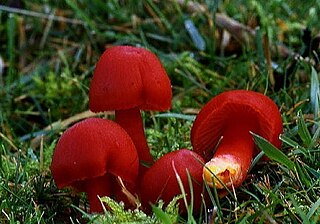
Hygrocybe coccinea, sometimes called the scarlet hood, scarlet waxcap or righteous red waxy cap, is a colourful member of the mushroom genusHygrocybe. These waxcaps are found across the Northern Hemisphere from China and Japan to Europe and North America. The small bright red mushroom is a familiar sight in unimproved grasslands in Europe in late summer and autumn, and woodlands in North America in winter.

Hydnellum caeruleum is an inedible fungus found in North America, Europe, and temperate areas of Asia. It is commonly known as the blue-green hydnellum, blue spine, or blue tooth.
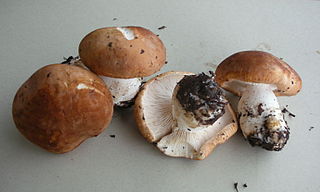
Leucopaxillus gentianeus is a bitter-tasting, inedible mushroom commonly known as the bitter false funnelcap, or the bitter brown leucopaxillus. A common synonym is Leucopaxillus amarus. The bitter taste is caused by a triterpene called cucurbitacin B. The species was first described in 1873 as Clitocybe gentianea by French mycologist Lucien Quélet. František Kotlaba transferred it to Leucopaxillus in 1966.

Alloclavaria purpurea is a coral fungus commonly known as the purple coral, or the purple fairy club. Formerly known as Clavaria purpurea, it has been moved to its own genus as a result of phylogenetic analysis.

Cortinarius collinitus is a species of fungi in the family Cortinariaceae.

Geastrum fornicatum, common name known as the acrobatic earthstar or the arched earthstar, is an inedible species of mushroom in the family Geastraceae. Like other earthstar mushrooms, the thick outer skin splits open at maturity to expose the spore sac to the elements; the specific epithet fornicatum refers to the arched shape of the rays which extend downwards to rest on the mycelial sac and elevate the spore sac.

The inedible wild mushroom Russula fragilis, which goes by the common name of the fragile brittlegill, is a member of the genus Russula, whose members are commonly known as brittlegills. It is a small, fragile, long stemmed, and variably coloured brittlegill, found in mixed forests, and woods in Europe, Asia, and North America.

Grifola frondosa is a polypore mushroom that grows at the base of trees, particularly oaks. It is typically found in late summer to early autumn. It is native to China, Europe, and North America.

Tricholoma saponaceum, also known as the soap-scented toadstool, soapy knight or soap tricholoma is an inedible mushroom found in woodlands in Europe and North America.

Entoloma abortivum, commonly known as the aborted entoloma or shrimp of the woods, is an edible mushroom in the Entolomataceae family of fungi. Caution should be used in identifying the species before eating. First named Clitopilus abortivus by Miles Joseph Berkeley and Moses Ashley Curtis, it was given its current name by the Dutch mycologist Marinus Anton Donk in 1949.
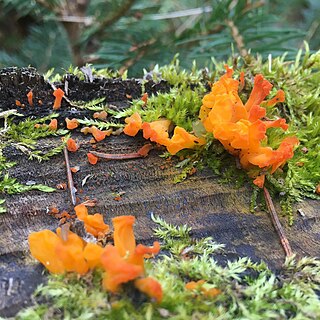
Dacrymyces palmatus is a species of jelly fungi in the family Dacrymycetaceae, and is nonpoisonous. It is alternately reported to be both edible and inedible.

Asterophora lycoperdoides is a species of fungus in the Lyophyllaceae family. It grows as a parasite on other mushrooms, mainly those in the genus Russula. Its gills are poorly formed or nearly absent. Asexual spores are produced on the mushrooms cap which enable the organism to clone itself easily. The spores are star-shaped, hence the name star bearer. It is regarded as nonpoisonous but inedible.

Rhodocollybia maculata, common name Spotted Toughshank, is a species of fungus in the mushroom family Marasmiaceae. It often appears around rotting conifer wood.
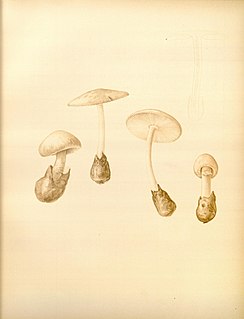
Amanita volvata, also known as volvate amanita is an inedible white-coloured species of fungi from the family Amanitaceae found in the southeastern United States. Can be confused with Amanita ponderosa, but that species is from the Iberian peninsula. The species is amyloid and have saccate volva, and elliptic spores.

Amanita excelsa, also known as the European false blushing amanita, is a species of agaric fungus in the family Amanitaceae. It is found in Asia, Europe, and North America, where it grows in deciduous forests.

Pholiota squarrosoides is a species of mushroom in the family Strophariaceae. It is similar to the species Pholiota squarrosa. There are differing accounts on whether the mushroom is edible.



















